45 Latest Influencer Marketing Statistics (2024 Data)

Influencer marketing is one of the fastest growing marketing strategies to ever hit the digital marketing industry.
Influencer marketing is the practice of sponsoring influential creators of all sizes by paying them to create and publish branded content to their social media profiles.
It’s essentially a social media marketing strategy that uses someone else’s following instead of your own.
Usually, that someone is an influencer with a built-in, highly-engaged audience that happens to be a perfect match for your product or service.
Fortunately, the industry has grown large enough to output a lot of data we can study and learn from.
In this post, we’ve rounded up the best influencer marketing statistics from around the web.
They’re organized in a variety of different categories, including general statistics, financial statistics, social media statistics and more.
Editor’s top picks – influencer marketing statistics
These are the most interesting statistics about influencer marketing:
- 83% of marketers believe influencer marketing to be an effective form of marketing. (Source: IMH)
- The influencer marketing industry is expected to grow to $21.1B in 2023. (Source: IMH)
- 32% of marketers say influencer marketing is most effective at increasing engagement rates. (Source: Statista2)
- 52% of brands report sponsoring creators as a top social media marketing strategy. (Source: CreatorIQ)
General influencer marketing statistics
1. 50% of marketing agencies say more than 75% of their marketing campaigns were sponsored in 2022
CreatorIQ surveyed hundreds of marketers and creators.
They found that 50% of marketing agencies reported that 75% of the marketing campaigns they launched in 2022 were sponsored.

Source: CreatorIQ
2. 23% of influencers say paid content makes up 25-50% of the content they publish
CreatorIQ’s survey found that 23% of influencers dedicate 25-50% of their social media marketing calendars to paid content.

However, 48% dedicate less than 25% of their content to paid content.
Source: CreatorIQ
Related: How Do Influencers Make Money? The Complete Guide.
3. The majority of influencers receiving brand deals live in the United States
Collabstr surveyed over 50,000 influencers for their 2023 Influencer Marketing Report.
They found that the majority of influencers who receive brand deals do so from the United States.

Other countries/regions cited by the report as being popular for influencer marketing include Canada, the UK, Australia, Germany and Mexico.
Source: Collabstr
4. Fashion and beauty are the most saturated influencer marketing niches
Influencer Marketing Hub’s State of Influencer Marketing Benchmark Report for 2023 found fashion and beauty to be the most popular category for influencer marketing, making up 25% of 3,500 respondents.
This is up by 10% of the previous year’s report.
These are additional categories the remaining respondents are in:
- Gaming – 12.9%
- Travel & Lifestyle – 12.5%
- Sports – 12%
- Family, Parent & Home – 10.7%
- Health & Fitness – 6.8%
- Other – 19%

Other popular niches cited in Collabstr’s report, which uses data collected from over 50,000 influencers, include Model, Comedy & Entertainment, Food & Drink, Music & Dance, and Art & Photography.
Source: Influencer Marketing Hub (IMH)
5. 83% of marketers believe influencer marketing to be an effective form of marketing
Influencer Marketing Hub’s survey found that 83% of marketers find influencer marketing to be an effective form of marketing.

That number has increased by 80% since the company’s 2017 survey, though it’s 7% lower than 2022’s response.
In 2022, 90% of marketers believed influencer marketing was an effective form of marketing.
Source: IMH
6. 69% of marketers prefer to partner with smaller influencers
Influencer Marketing Hub asked marketers about the size of influencers they’re most likely to work with in 2023.
39% said nano influencers, 30% said micro influencers, 19% said macro influencers while only 12% said mega influencers or celebrities.
To be clear, the company described nano influencers as those with 1,000 to 10,000 followers, micro influencers as those with 10,000 to 100,000 followers, and macro influencers as those with 100,000 to 1 million followers.
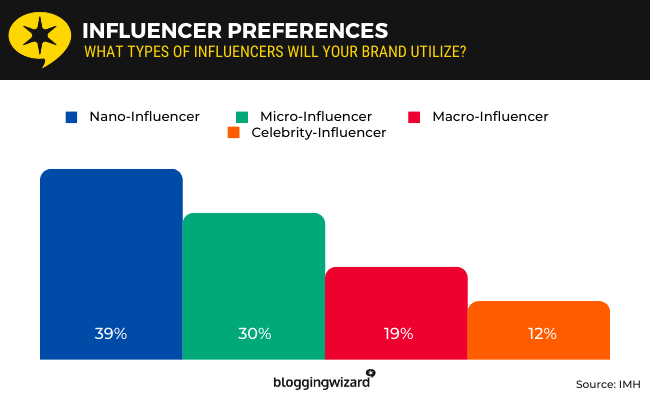
Related Reading: 16 Types Of Influencers You Need To Know.
Furthermore, 48% of marketers run influencer campaigns monthly as opposed to the 18% of marketers who run campaigns quarterly.
This was a big change from the previous year’s report, which found that 34% of marketers preferred to run campaigns monthly while 35% ran them quarterly.
This year, 19% run campaigns whenever they launch new products while 15% run campaigns year round.
As for influencers?
Aspire’s data revealed that 70% of influencers prefer to work with brands through long-term digital marketing campaigns where they publish multiple posts over longer periods of time.

23% prefer one-off campaigns while 3% prefer to work independently from brands but receive compensation through affiliate commissions.
Source: IMH
7. 59% of marketers worldwide say influencers can become more valuable to brands by generating interest
According to a survey of marketers worldwide in August of 2022, 59% of marketers say influencers can become more valuable to brands by creating content that generates interest and increases purchase intent.
51% say influencers become more valuable when they can create suitable content for brands.
Source: Statista1
8. 32% of marketers say influencer marketing is most effective at increasing engagement rates
According to a survey of marketers around the world in August of 2022, 32% of marketers use influencer posts to increase engagements.
This is the most effective outcome of influencer marketing.
19% say working with influencers increases social media traffic while 11% say these types of campaigns increase brand metrics.
Source: Statista2
9. 36% of marketers look at content production when selecting new influencers
In Influencer Marketing Hub’s survey for 2023, 36% of respondents said they value content production most when deciding which influencers to work with.
29% look at the relationship social media influencers have with their target audience.
This is a 22% drop from 2022’s survey.
17% value distribution while 7.5% value attribution and tracking.
Furthermore, 45% of marketers say their primary objective when launching an influencer marketing campaign is to generate user-generated content.
29% want to generate more sales while 26% want to raise brand awareness.
Source: IMH
10. Shein was mentioned by 13,400 TikTok influencers in 2022
According to Statista, Chinese ecommerce retailer Shein was mentioned by over 13,000 influencers on TikTok in 2022.
A big portion of those mentions were negative as many TikTokers and general consumers alike became aware of the ecommerce giant’s alleged poor working conditions in 2022, but it just goes to show you how buzz, good or bad, generated on TikTok can alter a brand’s image in a short period of time.

With that said, Target was mentioned by 11,200 influencers while Netflix was mentioned by 8,500.
Source: Statista3
11. 66,400 Instagram influencers mentioned ZARA on the platform in 2022
While Statista’s official data states that Instagram was the most talked about brand on Instagram in 2022 with 85,500 mentions, Zara followed close by with 66,400 influencers mentioning the retail brand in 2022.
Source: Statista4
12. The number of companies offering influencer marketing services grew by 75% between 2019 and 2021
According to Statista, 18,900 companies offered services related to influencer marketing in 2021.
This was a 75% increase from the number of companies who offered related services in 2019, demonstrating just how much the influencer marketing industry has grown in a short amount of time.
Source: Statista5
13. 58% of marketers who worked with influencers also worked with creatives
Aspire surveyed 700 marketers and influencers.
They found that 58% of marketers reported working with creatives in the last year, alongside working with social media influencers.

52% partnered with affiliates, 46% worked with brand ambassadors, 44% partnered with loyal customers, 39% collaborated with industry professionals and 28% partnered with employees.
Source: Aspire
14. 22% of brands struggle to scale their influencer marketing programs
CreatorIQ surveyed hundreds of brands and influencers between August and September of 2022.
They asked brands about the struggles they face in regards to influencer marketing.
22% reported challenges with scaling their influencer marketing programs while 16% struggle to retain partnerships with influencers.
Furthermore, 45% of brands have an inadequate number of marketing personnel dedicated to influencer marketing.
Specifically, they either have one dedicated person from their marketing team working on influencer marketing campaigns, two or none.
32% of brands struggle to encourage influencers to post on a consistent basis.
Source: CreatorIQ
15. 88% of brands use at least one influencer marketing platform
In CreatorIQ’s survey, 88% of brands reported using one to three influencer marketing software tools.
47% admitted to expanding their budgets to include such tools.
Popular options include Grin, Upfluence and Creator.co.
However, the same survey states that 71% of marketers report manual discovery to be the most common way for them to find new influencers to collaborate with.
Source: CreatorIQ
16. 64% of influencers say they used an influencer marketplace to connect with brands
Influencers have multiple ways they can reach out to brands for sponsorship deals, but 64% would prefer to use an influencer marketplace.
Only 15% use agencies to connect with brands.
Source: CreatorIQ
17. 40% of marketers say reach is the most important performance metric of influencer marketing campaigns
40% of respondents of CreatorIQ’s survey voted for “impressions or reach” as the #1 most important performance metric when reviewing results from influencer marketing campaigns.
Engagement rates came in second at 33%.
Source: CreatorIQ
18. 45% of influencers use the words “creator” and “influencer” interchangeably
CreatorIQ asked over 250 influencers how they feel about two titles they and the web as a whole use to describe individuals who publish content to social media and grow a following as a result.
While 47% prefer the term “creator,” 45% use “creator” and “influencer” interchangeably.
Only 8% prefer the term “influencer.”
This is likely attributed to the trust content creators build with their audiences.
The term “influencer” winds up feeling predatory as a result.
Source: CreatorIQ
19. 67% of influencers are willing to work with brands that aren’t their favorites
CreatorIQ’s data found that 67% of influencers are willing to work with brands that aren’t necessarily their favorites, so long as they like or trust those brands.
24% only work with brands they love.
8% are willing to work with low-quality brands if they’re compensated well.
Source: CreatorIQ
Financial influencer marketing statistics
20. The influencer marketing industry grew to $16.4B in 2022
When Influencer Marketing Hub launched in 2016, influencer marketing was only a $1.7B industry.
That number grew to $16.4B by the end of 2022.
Furthermore, the industry did not slow down as a result of the COVID-19 pandemic, as predicted.
Source: IMH
21. The influencer marketing industry is expected to grow to $21.1B in 2023
While the industry’s market size started at $1.7B when Influencer Marketing Hub was founded, it grew to $16.4B by the end of 2022.

That number is expected to grow even more in 2023, all the way up to $21.1B.
Source: IMH
22. 82% of global influencer marketing spend is allocated to the United States alone
Collabstr analyzed over 7,000 paid collaborations in their 2023 Influencer Marketing Report.
They found that 82% of influencer marketing spend from around the world is spent in the US alone.
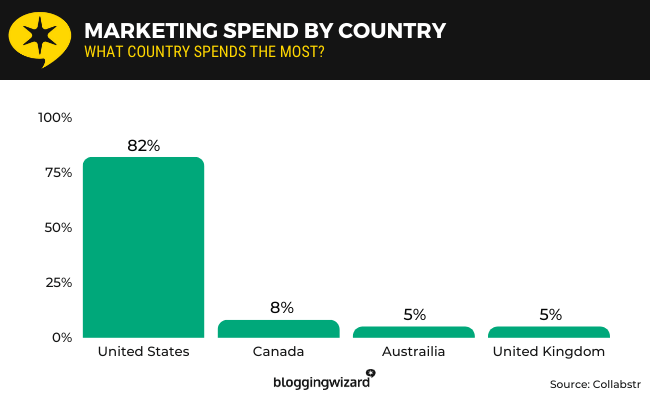
8% was spent in Canada, 5% was spent in the UK and another 5% was spent in Australia.
Source: Collabstr
23. 82% of marketers plan to adopt an influencer marketing budget in 2023
Influencer marketing budgets help organizations plan influencer marketing campaigns more effectively.
That’s probably why Influencer Marketing Hub’s survey found that 82% of the 3,500 marketers who responded to the survey plan on creating influencer marketing budgets in 2023.
Source: IMH
24. 67% of marketers will spend more of their budgets on influencer marketing in 2023
Influencer Marketing Hub’s survey found that 67% of marketers admitted they would increase their influencer marketing spend in 2023.

15% will spend the same as they did throughout the previous year while 11% aren’t sure how much they’ll spend.
7% will decrease the amount they spend on influencer marketing in 2023.
Furthermore, 23% will spend more than 40% of their budgets on influencer marketing alone.
25% will spend 10-20% of their budgets on influencer marketing, 20% will spend less than 10%, 18% will spend between 20 and 30% while 13% will spend between 30 and 40% of their budgets on influencer marketing.
Source: IMH
25. 11% of marketers spend more than $500,000 on influencer marketing annually
Influencer Marketing Hub’s survey found that 11% of marketers admitted to spending over $500,000 on influencer marketing annually.
However, 43% spend less than $10,000.
22% spend between $10,000 and $50,000, 14% spend between $50,000 and $100,000, and 10% spend between $100 and $500,000.
It should be noted that 38% of the survey’s respondents were from companies that had less than 10 employees.
21% were from companies with 10-50 employees, 16% were from companies with more than 1,000 employees, 12% were from companies with 50-100 employees, and 12% were from companies with 100-1,000 employees.
Source: IMH
26. 70% of influencers increased their marketing rates in 2023
Aspire asked influencers if their rates increased, decreased or stayed the same throughout the last year.
70% said their rates increased while 28% said their rates stayed the same.
Only 2% of influencers decreased their rates.
Inflation likely contributed to this metric, along with marketers growing their audiences and needing to increase their rates along the way.
Source: Aspire
27. Specifically, influencers charge an average of $257 for brand collaborations
Collabstr’s data on marketing spend revealed that influencers charge an average of $257 for paid collaborations.
They also broke that statistic down by social media platform.

On average, influencers charge $363 on Instagram, $460 on TikTok, $791 on YouTube and $396 on user-generated content.
Collabstr also uncovered data about what brands are actually paying for collaborations.
Those metrics are $183 on Instagram, $203 on TikTok, $418 on YouTube and $227 for user-generated content.
Here’s a breakdown of what percentage of the original asking price influencers receive per platform:
- Instagram – 50.51%
- TikTok – 44.13%
- YouTube – 52.85%
- User-Generated Content – 57.23%
Source: Collabstr
28. The Lifestyle niche is most expensive with influencers charging an average of $994 per collaboration
Collabstr’s 2023 Influencer Marketing Report uncovered metrics on the average price influencers charge by niche:
- Lifestyle – $994
- Health & Fitness – $979
- Comedy & Entertainment – $968
- Travel – $939
- Food & Drink – $918
- Fashion – $912
- Model – $864
- Beauty – $860
- Music & Dance – $850
- Art & Photography – $818

Source: Collabstr
29. 41.6% of marketers compensate influencers with cash payments
While distributing free samples has been the dominating strategy for compensating influencers for quite some time, more marketers (41.6%, to be exact) are now negotiating with influencers for monetary compensation.
29.5% still use free samples, to be fair.
In fact, Aspire’s survey found that 54% of influencers are willing to accept free products from brands if the product value is high.
29% would agree to receiving free products as payment if they love the brand offering them.
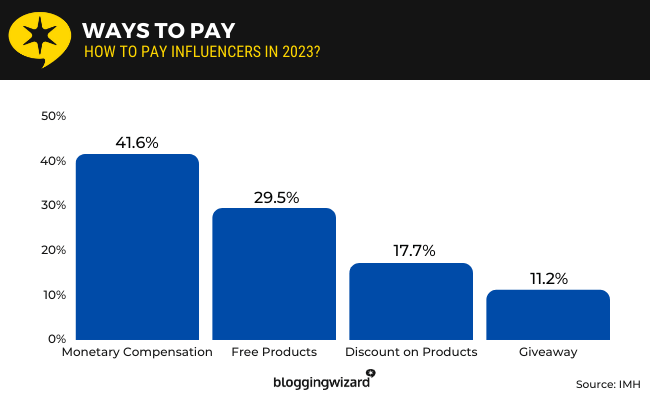
17.7% offer discounts on products while 11.2% use giveaways.
Source: IMH
30. Only 19.6% of marketers will pay influencers at a flat rate in 2023
This statistic hints at a major shift in the way influencers get paid for marketing products for brands in 2023 (and possibly beyond).
In Influencer Marketing Hub’s 2022 survey, 49% of respondents said they would pay influencers a flat rate for marketing deals.
That number dropped to just 19.6% in the company’s 2023 survey.
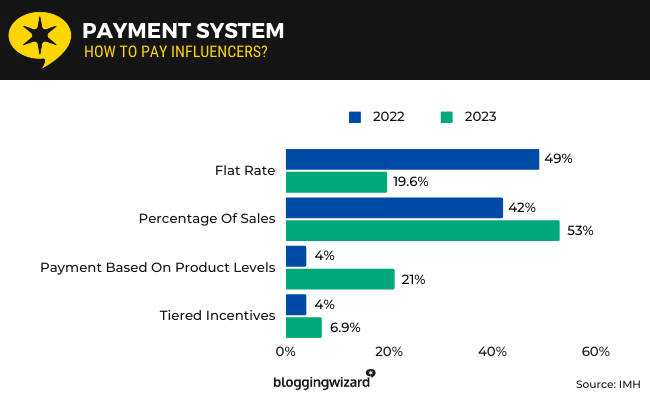
A whopping 53% will pay influencers a percentage of each sale they generate while 21% will issue payments based on product level.
6.9% will offer tiered incentives.
Source: IMH
31. 78% of influencers will stop posting about a brand if they aren’t compensated
CreatorIQ’s survey found that 78% of influencers would stop publishing content about a particular brand that’s sponsoring them if they aren’t given the monetary compensation they agreed upon in a timely manner.
64% would stop posting about a brand if the product was low in quality or if the level of service they’re given is poor.
In fact, 43% of influencers say product quality is the most important factor they consider when choosing brands to collaborate with.
24% say compensation is most important while 20% review a brand’s values, such as sustainability, inclusivity and more.

Source: CreatorIQ
32. The average maximum price of a sponsored YouTube video was $16,234 in 2022
In 2022, marketers who sponsored YouTube videos spent an average of $16,234 per video at maximum.
Videos with more than 1 million views had an average minimum sponsored post rate of $2,500 in the US.
The average minimum sponsored post rate for a video with 500,000 to 1 million views was $1,105.
Source: Statista6
33. YouTube has the lowest cost per engagement (CPE) with an average CPE of $0.04
YouTube is the cheapest platform to generate engagements with. Each engagement (view, like, comment or share) only costs $0.04.

Twitter is the most expensive platform to utilize influencer marketing with.
It has a CPE of $37.82.
Source: Aspire
34. Nano influencers charge the least and have an average CPE of $0.06 on TikTok
Nano influencers have a cost per engagement of $0.06 on TikTok, $0.59 on Instagram and $0.25 on YouTube.

Interestingly, CPE is cheaper among micro, mid-tier and macro accounts when it comes to YouTube.
Source: Aspire
Social media marketing statistics
35. 52% of brands report sponsoring creators as a top social media marketing strategy
CreatorIQ asked brands about their top social media strategies.
Sponsoring creators by sending them free products and encouraging them to post about it was voted as a top strategy by 52% of marketers.
42% reported sharing user-generated content to branded social media channels.
Source: CreatorIQ
36. 82% of influencers use Instagram for influencer marketing
Collabstr surveyed over 50,000 influencers who offer influencer marketing services to brands.
A whopping 82% use Instagram.

61% use TikTok while only 9% use YouTube for influencer marketing.
26% of influencers offer paid services for user-generated content.
Source: Collabstr
37. 42% of marketers believe TikToks will deliver the greatest ROI in 2023
When it comes to influencer marketing ROI, 42% of marketers believe short clips from TikTok will return the greatest number of conversions in 2023, according to Influencer Marketing Hub’s survey.
34% voted for Instagram Reels, 19% voted for YouTube Shorts and 6% voted for Snapchat Spotlights.
The company didn’t include Facebook Reels in their survey options.
This is in line with another metric from the company’s report, which states that TikTok is the most common social media marketing platform used by brands for influencer marketing.

55.5% of brands use TikTok, whereas 50.8% use Instagram, 42.1% use Facebook and 38.3% use YouTube.
This extra set of data also reveals how Facebook is still one of the most relevant social media platforms for influencer marketing, even if Influencer Marketing Hub didn’t ask marketers about their use of Facebook Reels in their survey.
Source: IMH
38. 55% of marketers say Reels are the most effective form of influencer marketing on Instagram
Instagram was the most effective platform in CreatorIQ’s report.
66% of marketers say they received their greatest ROIs from Instagram.
55% say Instagram Reels was most effective followed by posts (20%), stories (16%) and collab posts (8%).
Source: CreatorIQ
39. 73% of brands plan to use Snapchat the least in 2023
Aspire surveyed over 700 brands and students and found that 73% plan on leaving Snapshot behind in 2023.
58% plan to use Twitter less, 43% Pinterest, 30% Blogger, 26% Facebook, 21% YouTube, 17% TikTok and 9% Instagram.

This is in line with most reports that find TikTok and Instagram to be influencers’ preferred social media platforms.
Source: Aspire
40. YouTube influencers with 100,000 to 1 million subscribers have an average engagement rate of 4.14%
According to Statista, the highest engagement rate on YouTube is 4.14%, a metric that comes from YouTubers with 100,000 to 1 million subscribers.
The lowest engagement rates come from channels with 1,000 to 5,000 subscribers.
Source: Statista7
41. Influencers who use multiple platforms receive most of their engagements from YouTube
Aspire analyzed thousands of posts and found that influencers receive an overwhelming majority of their engagements from YouTube videos, where they receive a collection of 78,519 views, likes, comments and shares on average.

TikTok was another huge source of engagements with an average number of 6,289 engagements from likes, comments and shares.
Source: Aspire
Content marketing statistics
42. 71% of marketers increased their content output in 2022
Influencer Marketing Hub’s report found that, out of 3,500 respondents, 71% admitted to increasing their content output in 2022.
While this was a 13% drop from 2021’s 84% of marketers, it still demonstrates an understanding of the importance of content among most marketers.
Source: IMH
43. 63% of marketers have a budget dedicated to content marketing
63% of the 3,500 respondents who participated in Influencer Marketing Hub’s survey admitted to having a standalone budget for content marketing.
That number increases every year.
61% had a dedicated content marketing budget in Influencer Marketing Hub’s 2022 survey, 59% in 2021 and 55% in 2020.
Source: IMH
44. 94% of brands will invest in video content in 2023
Aspire’s report on influencer marketing revealed that 94% of brands plan on investing most of their content marketing budgets in video content in 2023.

43% will invest in images while 26% will invest in written content.
Source: Aspire
45. 82% of brands repurpose influencer content
When brands partner with influencers to create high-quality, engaging content for both audiences, 82% of brands repurpose that content.
18% only publish that content to the original source.
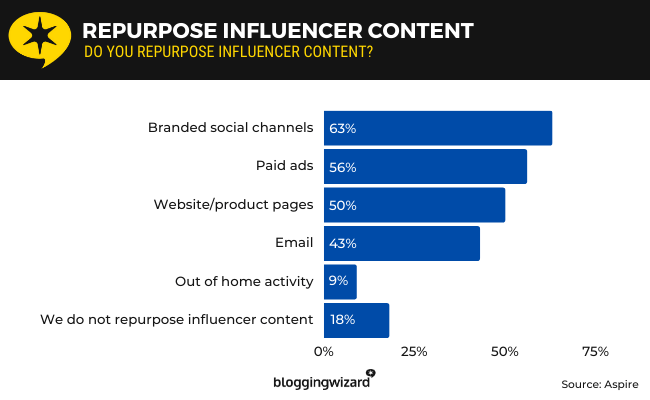
Of the 82% who repurpose content, 63% publish it to branded social media channels.
56% repurpose it as an ad, and 50% add it to product and certain web pages.
43% repurpose it in email content, and 9% use a traditional marketing strategy, such as billboards.
Source: Aspire
Influencer marketing statistics sources
Final thoughts
We hope you learned something new from our collection of influencer marketing statistics.
The data can be a little sporadic here and there as reporting agencies have vastly different customer bases to survey, but we can still spot a few trends.
The most obvious are the web’s top platforms for influencer marketing: Instagram and TikTok.
As TikTok’s popularity increased among social media users, so did its popularity among marketers.
YouTube is a somewhat underutilized platform for influencer marketing, even though it has some of the highest engagement rates for this marketing strategy.
We also learned that sending free products to influencers is still a valid way to achieve most of the marketing goals you want to accomplish with influencer marketing.
If you want to apply what you learned from the influencer marketing statistics on this page, join a tool like Upfluence, and get the process started today.
Related reading:
- The Beginner-Friendly Guide to Influencer Marketing
- The Best Influencer Marketing Research Tools
- The Latest Social Media Stats You Need To Know
- How to Build a Social Media Marketing Strategy
- The Best Social Media Management Tools
- What is Affiliate Marketing?
- 22 Eye-Opening Creator Economy Statistics
